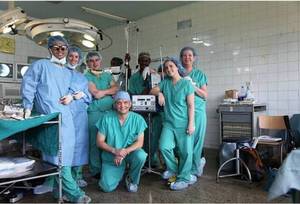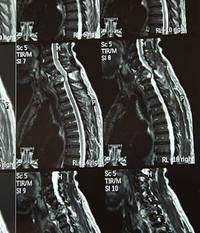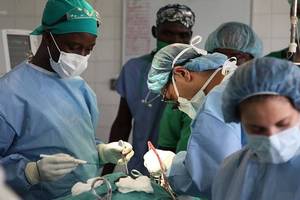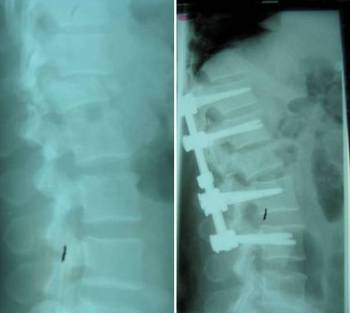Neurosurgery Mission to Bugando, May 2010
Return to Bugando
While the visit in 2009 was meant to assess the neurosurgical needs and capabilities at Bugando, this year’s mission had the goal of responding to those specific needs by starting a long-term commitment to help the medical staff at Bugando cope with their tremendous task of treating neurosurgical diseases. As we have previously shown, from a neurosurgical perspective the main pathologies that are relevant in East Africa involve children and young adults, and include traumatic brain injuries, spinal trauma, spinal infection and congenital disorders such as hydrocephalus and myelomeningoceles (1). Bugando covers a population of up to 15 million people and the neurosurgical pathology seen in terms of volume, extent and severity is overwhelming. Currently there is only one practicing neurosurgeon in Tanzania who works in the capital in Dar es Salaam, 700 miles away. Therefore, with the support of the local hospital administration under the guidance of Dr. Majinge, the Surgery Department led previously by Dr. Mahalu, and now by Dr. Gilyoma, and in cooperation with the Tanzanian Department of Health, we decided to identify and train interested and motivated young general surgeons in basic neurosurgical techniques and principles to address the previously mentioned pathologies. This concept has previously been described and worked well in other hospitals in developing countries where non-neurosurgeons were trained to address basic neurosurgical emergencies (2).
During our previous visit and with the guidance of Dr. Majinge and Dr. Mahalu we identified Dr. Emmanual Kahumba who has a special interest in pediatric and general neurosurgery and Dr. Isidor Ngayomela, an orthopedic surgeon who wants to specialize in the treatment of spinal disorders, as the most likely candidates. Our visit had shown that congenital malformations such as hydrocephalus and myelomeningoceles were treated occasionally and with probably good results, but that the treatment of traumatic brain injuries (TBI), spinal trauma and other neurosurgical diseases such as brain tumors was almost non-existent or required transfer of patients to Nairobi or Dar es Salaam, which was feasible or possible only in a small minority of cases. We also identified significant deficits in the operating room and ICU set-up, equipment, maintenance and organization that make it a challenge to successfully introduce basic neurosurgery. Therefore, we decided to focus our activities on education and on the surgical and non-surgical treatment of TBI and spinal trauma. We were able to bring in generous donations from several companies that provided surgical equipment vital for neurosurgery: Anspach donated 2 new surgical drills that allowed the local team for the first time to perform state of the art craniotomies and spinal procedures, Synthes once again donated spinal instrumentation worth approximately half a million US$ and two other spine companies, Nuvasive and Depuy Spine supported our resident program with funds to cover travel and stay in Tanzania. The Brain Trauma Foundation in New York provided educational material for the training of management of severe TBI.After our initial visit in 2009 there were two other neurosurgical groups who visited Bugando, one group from Harvard and one resident from the Barrow’s Neurological Institute in Phoenix. We were in close contact with these groups and tried to coordinate our activities as much as possible.Back to Work Picture 1We arrived at Bugando with two neurosurgeons, one attending and one resident, one neuro-anesthesiologist, one nurse anesthesist, one operating room nurse and one medical student (Picture 1). We received a very warm welcome and were generously supported throughout our short visit. We were happy to realize that the equipment that we previously brought over in 2009 was still there, was maintained properly and actually was used for a number of cases. Together with Emmanual and Isidor we spent three busy days in the operating room the first week. Bugando has only five operating rooms and we are thankful that we had the opportunity to get operating room time and lots of support from the local surgeons and OR for those three days.The cases we completed serve as an example of a successful and effective collaboration, not only between the local hospital team and the visiting surgical team, but also between the various outside collaborators, who don’t necessarily overlap in terms of the times of their visits. Dr. Mark Garrett from Phoenix was in Mwanza a few weeks before our arrival and we were able to coordinate the treatment of two spinal cases that he operated on emergently and that required subsequent stabilization.
Picture 1We arrived at Bugando with two neurosurgeons, one attending and one resident, one neuro-anesthesiologist, one nurse anesthesist, one operating room nurse and one medical student (Picture 1). We received a very warm welcome and were generously supported throughout our short visit. We were happy to realize that the equipment that we previously brought over in 2009 was still there, was maintained properly and actually was used for a number of cases. Together with Emmanual and Isidor we spent three busy days in the operating room the first week. Bugando has only five operating rooms and we are thankful that we had the opportunity to get operating room time and lots of support from the local surgeons and OR for those three days.The cases we completed serve as an example of a successful and effective collaboration, not only between the local hospital team and the visiting surgical team, but also between the various outside collaborators, who don’t necessarily overlap in terms of the times of their visits. Dr. Mark Garrett from Phoenix was in Mwanza a few weeks before our arrival and we were able to coordinate the treatment of two spinal cases that he operated on emergently and that required subsequent stabilization.
Case 1  Picture 2
Picture 2
The first case was a young woman with an infection and collapse of the C6 and C7 vertebral bodies that resulted in a rapidly progressive paraparesis (Picture 2). Via e-mail we discussed the case and Dr. Garrett decided to go ahead with a decompression in order to save the patient’s neurological function. The operation was successful and showed as most likely diagnosis TB, but there was a great concern regarding the stability of the spine because the infection and the subsequent operation had caused significant instability. We are able to use the equipment that we brought in to perform a posterior stabilization 10 days after his initial operation (Picture 3). The patient’s neurological function recovered almost back to normal after surgery.
 Picture 3 Case 2Another case involved a young woman in her 20s who fell into a well resulting in a L1 burst fracture with spinal cord compression and significant lower extremity weakness (Picture 4). Dr. Garrett went ahead and performed a limited decompression which saved the patient’s neurological function. We completed the operation by performing a stabilization that allows her to get mobilized early on without the fear of developing progressive deformity, neurological dysfunction and a chronic pain syndrome and other complications of prolonged bedrest such as DVT, PE, muscle atrophy and skin ulcers and infections (Picture 5).
Picture 3 Case 2Another case involved a young woman in her 20s who fell into a well resulting in a L1 burst fracture with spinal cord compression and significant lower extremity weakness (Picture 4). Dr. Garrett went ahead and performed a limited decompression which saved the patient’s neurological function. We completed the operation by performing a stabilization that allows her to get mobilized early on without the fear of developing progressive deformity, neurological dysfunction and a chronic pain syndrome and other complications of prolonged bedrest such as DVT, PE, muscle atrophy and skin ulcers and infections (Picture 5). Pictures 4 and 5 Very significant work and a concerted effort between visiting surgical groups from the outside and the local team at Bugando are necessary to make this project work long-term. Communication between visiting groups and with the target surgeons at Bugando as well as the surgery and hospital leadership are crucial to make this project a success.
Pictures 4 and 5 Very significant work and a concerted effort between visiting surgical groups from the outside and the local team at Bugando are necessary to make this project work long-term. Communication between visiting groups and with the target surgeons at Bugando as well as the surgery and hospital leadership are crucial to make this project a success.
Impressions and comments from:
- Kane Pryor, Neuro- Anesthesiologist
Bugando is a WHO Level 3 Referral Hospital with only Level 2 District Hospital anesthetic capabilities. The main surgical complex contains five operating rooms, each of which is equipped for the administration of general anesthesia. Anesthesia services are almost exclusively provided by nurse anesthetists, who are assisted by a large number of students. The student ratio is high (4-5 per room), and it is difficult to see how adequate training opportunities can be provided at the level of the individual. The head of the department is a physician (one of only ten or so in the country), but his role seems to largely involve teaching during the morning report conference. Many of the anesthesia practitioners have good manual skills, and generally a good intuitive sense of intraoperative management. However, anesthetic practice deviates profoundly from that in developed nations on three major levels. The first derives from a lack of material resources. The hospital has acquired sophisticated anesthesia machines for each of the ORs, but simple disposables, such as EKG pads, pulse oximeter probes, and carbon dioxide absorbent are absent. Similarly, the range of drugs available is highly limited, with certain categories such as beta adrenergic blockers, bronchodilators, anticoagulants and selective vasopressors or inotropes completely absent. Halothane is the only available volatile agent, and because of the absence of carbon dioxide absorbent, standard practice is to use high oxygen flows with exhaust gases flowing passively into the OR. The second challenge derives from a knowledge deficit: while I met many bright and enthusiastic practitioners, it was very clear that the depth and breadth of knowledge was inadequate for them to be able to analyze and respond to the range of possible clinical scenarios facing them. Access to texts and reference material is highly limited, and there does not appear to be a systematic training program. The third challenge is a lack of systems-based management approaches for equipment, training, and practice. Indeed, one of the initial objectives for future missions will be to devise systems to ensure that donated supplies and equipment find their way to the places where they are needed, when they are needed. The deficits are great, but there is reason for much hope. While bringing Bugando to a point of broad capabilities would appear to a long-term goal, the safety of anesthesia administration could be improved enormously with a small set of simple and cheap initiatives. Our first goal is to ensure that every anesthetic patient at Bugando is appropriately monitored with pulse oximetry, EKG, blood pressure, and carbon dioxide sampling. Concurrently, future visits will conduct workshops to train practitioners to prevent, identify and intervene in some of the common intraoperative physiologic crises—events that can usually be addressed, but which are at present leading to morbidity and mortality.
- Lewis Leng, Neurosurgery Resident
This was my first trip to Bugando hospital and Tanzania. I found it to be an incredible experience and it helped me to better understand some of the needs and challenges in global health. I found the Bugando hospital surgeons, staff, and administration to be supportive and receptive of our efforts. I think for this endeavor to continue to progress, several key points need to be addressed. Communication, coordination, and organization needs to be improved on both sides. This will allow each successive effort to better build upon previous trips. This will also help the Bugando surgeons and staff to better integrate and implement recommendations made by visiting teams. We need to focus on more than just surgical aspects of neurosurgery. We need to address all levels of care for neurosurgical patients including anesthesia, OR nursing, perioperative nursing, OR management, and ICU management. Address small, incremental changes with each visit. Visiting teams can focus on specific goals that can be easily followed up on by future teams. The Bugando team would be able to better digest and incorporate recommendations from each trip. Focus on utilizing the resources that are in place already. I think future teams should be aware of the equipment and materials present already from local resources and previous donations. Electronic inventory and on-site organization will be key to this change. Future donations should be only directed at replenishing that supply. 5) By attempting a vertical intervention of neurosurgical care in the hospital, neurosurgery may eventually be a model that other surgical specialties can emulate.
- Lindsay Posner, Operating Room Nurse
As a returning visitor, I was happy to see that we have made progress since our last visit to Mwanza. Our team completed three spinal fusions in the operating room, cases that could not have been done during our initial visit to Bugando. We were also able to successfully educate nursing and surgical staff, regarding donated instruments and equipment. It is apparent however, that communication between Bugando and Madaktari is an issue that must be addressed. We found unused donated equipment such as drill bits, drains, a mayfield head holder, and an OR bed. In order to increase utilization, we must organize and document this donated neurosurgery equipment and supplies. In addition, educating Bugando staff on how to use this equipment is also important. The surgical and anesthesia staff seem enthusiastic and eager to learn. I believe that once we increase communication and organization, there is great potential for a neurosurgery program at Bugando.
- Brenna Stein, Nurse Anesthetist
As a first time anesthetist at the Bugando Medical Center, I was pleasantly surprised to find the set up not much different from what I am used to in New York. Although the anesthesia machine worked off a large O2 tank rather than central O2, it was a relatively new machine (Central gas access is being finalized). The monitor we had was the only one with ETCO2 capability. Each of the five rooms does general anesthetics either with LMAs or endotracheal tubes, so they should all have them. With the electrical fluctuations it is not unusual to have to keep resetting the monitor. Because of the cost of Isoflurane it is only used in cardiac cases. All other cases are done with Halothane. With the exception of narcotics, all medicines are kept in the anesthesia cart. Any empty ampule of narcotic has to be returned to the nurse for the final count of the day. We learned that after automatically throwing one into the waste box. Despite the routine practice of keeping patients intubated into recovery and just on room air, we were able to extubate all three of the cases that we did. The staff was friendly and open to inservice: ie-learning how to work the new electric table. They had requested us to bring a fiberoptic scope which we couldn't. When we examined theirs it seemed the problem was that the battery had never been charged. Once we charged it up, it worked perfectly as evidenced by our use of it to clear an obstructing L main stem bronchus plug. The anesthesia students asked pertinent questions-especially when we used the medicines differently from them. This was seen the most with succinycholine which is routinely used on every intubation. All patients arrive with a thorough pre-operative evaluation written by the student. It was, however, difficult to assess their level of knowledge as some spoke better english than others. In short, I had a very positive experience.
- Sophia Roser, Medical Student
As a medical student my visit to Bugando Hospital proved to be an invaluable experience. I gained insight into the difficulties and complexities of delivering health care in the developing world, which is not possible without first-hand experience. Establishing neurosurgical care at Bugando presents a multitude of challenges, however, I recognize it is a worthwhile and realistic goal. It will require a continuous and coordinated effort from visiting teams focusing, not only on instruction in neurosurgery, but also on improving the standard of anesthesia, peri-operative, and ICU care. Hopefully this kind of multi-disciplinary approach at Bugando will create benefits beyond neurosurgery, improving the care of surgical patients in general. With the continued dedication from Cornell and other institutions, I am optimistic about the progress and development of surgical care at Bugando in the future.
References:1. Hartl et al., The pattern of neurosurgical disorders in rural northern Tanzania: a prospective hospital-based study. World Neurosurgery 2010. In press2. Attebery et al., Initial audit of a basic and emergency neurosurgical training program in rural Tanzania. World Neurosurgery 2010. In press
Weill Cornell Medicine Center for Global Health
Center for Global Health
420 East 70th Street, 4th Floor, Suite LH-455
New York, NY 10021
Phone: (646) 962-8140
Fax: (646) 962-0285

